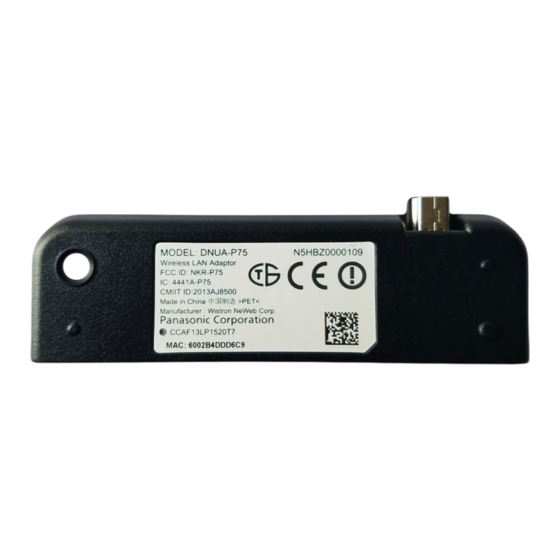
Advertisement
Wireless LAN Adaptor
(11abgn 2x2 USB)
Panasonic
DNUA-P75
User Manual
Copyright Statement
No part of this publication may be reproduced, stored in a retrieval system, or transmitted in any
form or by any means, whether electronic, mechanical, photocopying, recording or otherwise
without the prior writing of the publisher.
Pentium is trademark of Intel.
All copyright reserved.
Advertisement

Summary of Contents for Panasonic DNUA-P75
- Page 1 Wireless LAN Adaptor (11abgn 2x2 USB) Panasonic DNUA-P75 User Manual Copyright Statement No part of this publication may be reproduced, stored in a retrieval system, or transmitted in any form or by any means, whether electronic, mechanical, photocopying, recording or otherwise without the prior writing of the publisher.
- Page 2 Federal Communication Commission Interference Statement This equipment has been tested and found to comply with the limits for a Class B digital device, pursuant to Part 15 of the FCC Rules. These limits are designed to provide reasonable protection against harmful interference in a residential installation. This equipment generates, uses and can radiate radio frequency energy and, if not installed and used in accordance with the instructions, may cause harmful interference to radio communications.
- Page 3 Industry Canada statement: This device complies with Industry Canada licence-exempt RSS standard(s). Operation is subject to the following two conditions: (1) this device may not cause interference, and (2) this device must accept any interference, including interference that may cause undesired operation of the device.
- Page 4 MHz) doit se conformer à la limite de p.i.r.e. spécifiée pour l’exploitation point à point et non point à point, selon le cas. (iv) De plus, les utilisateurs devraient aussi être avisés que les utilisateurs de radars de haute puissance sont désignés utilisateurs principaux (c.-à-d., qu’ils ont la priorité) pour les bandes 5 250-5 350 MHz et 5 650-5 850 MHz et que ces radars pourraient causer du brouillage et/ou des dommages aux dispositifs LAN-EL.
- Page 5 Europe – EU Declaration of Conformity This device complies with the essential requirements of the R&TTE Directive 1999/5/EC. The following test methods have been applied in order to prove presumption of conformity with the essential requirements of the R&TTE Directive 1999/5/EC: IEC 60950-1:2005 (2nd Edition);...
- Page 6 Česky [Jméno výrobce] tímto prohlašuje, že tento [typ zařízení] je ve shodě se základními požadavky a dalšími příslušnými ustanoveními směrnice 1999/5/ES. [Czech] Dansk Undertegnede [fabrikantens navn] erklæ rer herved, at fø lgende udstyr [udstyrets [Danish] typebetegnelse] overholder de væ sentlige krav og ø vrige relevante krav i direktiv 1999/5/EF.
- Page 7 richtlijn 1999/5/EG. Malti Hawnhekk, [isem tal-manifattur], jiddikjara li dan [il-mudel tal-prodott] jikkonforma mal-ħtiġijiet essenzjali u ma provvedimenti oħrajn relevanti li hemm fid-Dirrettiva [Maltese] 1999/5/EC. Magyar Alulí rott, [gyártó neve] nyilatkozom, hogy a [... tí pus] megfelel a vonatkozó alapvetõ [Hungarian] követelményeknek és az 1999/5/EC irányelv egyéb elõí...
- Page 8 Taiwan 警語 第十二條→經型式認證合格之低功率射頻電機,非經許可,公司,商號或使用者均不得擅 自變更頻率、加大功率或變更原設計之特性及功能。 第十四條→低功率射頻電機之使用不得影響飛航安全及干擾合法通信;經發現有干擾現象 時,應立即停用,並改善至無干擾時方得繼續使用。 前項合法通信,指依電信法規定作業之無線電通信。 低功率射頻電機須忍受合法通信或工 業、科學及醫療用電波輻射性電機設備之干擾。 無線傳輸設備 (UNII) 在 5.25-5.35 秭赫頻帶內操作之無線資訊傳輸設備,限於室內使用。 (4.7.5) 無線資訊傳輸設備忍受合法通信之干擾且不得干擾合法通信;如造成干擾,應立即停用, 俟無干擾之虞,始得繼續使用。 (4.7.6) 無線資訊傳設備的製造廠商應確保頻率穩定性,如依製造廠商使用手冊上所述正常操作, 發射的信號應維持於操作頻帶中。(4.7.7)
-
Page 9: Table Of Contents
Table of Contents 1. INTRODUCTION 2. DRIVER/UTILITY INSTALLATION / UNINSTALLATION 9 3. CONNECTING TO AN EXISTING NETWORK 9 4. MODIFYING A WIRELESS NETWORK 4.1 M .................... 10 ODIFYING ENERAL ETTINGS 4.2 M ..................... 11 ODIFYING ECURITY ETTINGS 5. SPECIFICATIONS 13 APPENDIX A: FAQ ABOUT WLAN... -
Page 10: Introduction
1. Introduction Thank you for purchasing the 802.11 a/b/g/n USB Wireless LAN Adaptor that provides the easiest way to wireless networking. This User Manual contains detailed instructions in the operation of this product. Please keep this manual for future reference. System Requirements 128 MB of RAM or later (recommended) 300 MHz processor or higher... -
Page 11: Modifying A Wireless Network
4. Modifying a Wireless Network 4.1 Modifying General Settings 1. Use the remote control that came with your TV to access the network configuration settings page. 2. From the profile list, select one profile and choose the modify function. 3. Modify the settings below for your network. Profile Name Identifies the configuration wireless network profile. -
Page 12: Modifying Security Settings
4.2 Modifying Security Settings 1. Use the remote control that came with your TV to access the network configuration settings page. 2. Select a security option of this wireless network. This product provides security options below. Contact your wireless network administrator for choosing a correct option. ... - Page 13 None No security (not recommended). Allow Association to Check this check box if the access point with which the client adapter is Mixed Cells to associate has WEP set to Optional and WEP is enabled on the client adapter. Otherwise, the client is unable to establish a connection with the access point.
-
Page 14: Specifications
5. Specifications Dimensions: 91.5(L) * 31.3(W) * 7.82(H) mm Frequency range: USA: 2.400 ~ 2.483GHz, 5.15 ~ 5.35GHz, 5.47 ~ 5.725GHz, 5.725 ~ 5.85GHz Canada: 2.400 ~ 2.483GHz, 5.15 ~ 5.35GHz, 5.47 ~ 5.725GHz, 5.725 ~ 5.85GHz Taiwan: 2.400 ~ 2.483GHz, 5.25 ~ 5.35GHz, 5.47 ~ 5.725GHz, 5.725 ~ 5.85GHz Europe: 2.400 ~ 2.483GHz, 5.15 ~ 5.35GHz, 5.47 ~ 5.725GHz... -
Page 15: Appendix A: Faq About Wlan
Appendix A: FAQ about WLAN What is Spread Spectrum? Spread Spectrum technology is a wideband radio frequency technique developed by the military for use in reliable, secure, mission-critical communications systems. It is designed to trade off bandwidth efficiency for reliability, integrity, and security. In other words, more bandwidth is consumed than in the case of narrowband transmission, but the trade-off produces a signal that is, in effect, louder and thus easier to detect, provided that the receiver knows the parameters of the spread-spectrum signal being broadcast. - Page 16 What is roaming? Roaming is the ability of a portable computer user to communicate continuously while moving freely throughout an area greater than that covered by a single access point. Before using the roaming function, the workstation must make sure that it is the same channel number with the access point of dedicated coverage area.













